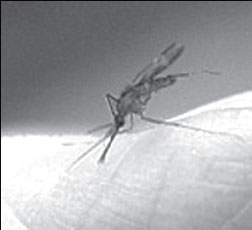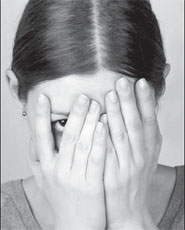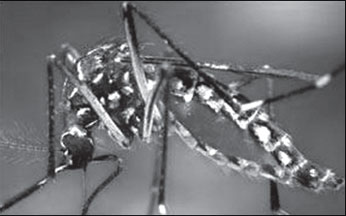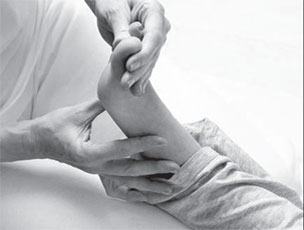|

Moving towards a malaria free Lanka
By Carol Aloysius
Once regarded as one of the most feared scourges in the island, when
literally thousands of people died from this disease during the colonial
regime and later in the early1960s, Sri Lanka is surely and rapidly
moving towards a Zero Malaria nation.
 Thanks to the efforts of the Health Ministry and the anti Malaria
Campaign, whose vision is to eliminate indigenous spread of the two most
common forms of malaria in the country, namely P. Falciparum by the year
2012 and P.Vivax by the year 2014, there has been a dramatic reduction
in the disease in the past decade from over 210,000 cases in the year
2000 to just 23 cases in 2012. Thanks to the efforts of the Health Ministry and the anti Malaria
Campaign, whose vision is to eliminate indigenous spread of the two most
common forms of malaria in the country, namely P. Falciparum by the year
2012 and P.Vivax by the year 2014, there has been a dramatic reduction
in the disease in the past decade from over 210,000 cases in the year
2000 to just 23 cases in 2012.
As Health Minister Maithripala Sirisena observed in his message for
World Malaria Day on April 18, the AMC has much to celebrate in its
centennial celebrations this year, since the number of positive cases in
2012 is the lowest since 1963.Yet although the burden of malaria has
come down significantly for Sri Lanka, with only sporadic cases reported
from some parts of the country and occasional outbreaks in certain
malaria risk areas, Health authorities are fully aware they cannot
afford to rest on their laurels.
Like any other disease which has seen such significant reductions in
this country, due to interventions on the part of the Health Ministry,
Malaria too can re-emerge, especially with migration of persons living
in endemic areas such as the Dry Zone which covers a vast regions
including the Anuradhapura district, Moneragala district and Uva
province, to non endemic areas.
Education, Awareness programs, constant examination of blood
specimens of high risk populations by trained medical officers, and
drugs to prevent malaria, are as important as public co-operation in
spraying their indoor walls with insecticides, using mosquito repellents
and mosquito nets and reporting to their nearest MOH office at the onset
of the disease.
The Sunday Observer spoke to Director, Anti Malaria Campaign Dr S. L.
Deniyage, to find out what the campaign was doing to achieve its target
of eliminating indigenous malaria in the country, maintaining zero
mortality rates from malaria, and most importantly preventing
re-introduction of malaria into the country.
We also asked him how the disease was caused, and how it could be
treated and prevented.
Excerpts…
Q: How is malaria caused?
A: It is caused by a single celled microscopic blood parasite
called plasmodium. The types of parasite common in Sri Lanka are (1)
p.vivax and (2) falciparum. The former does not cause serious
complications like the latter type which is causes serious illness with
several grave complications. There are two other types of the malarial
virus which are found in other parts of the world and not in Sri Lanka.
Q: Where is malaria found mostly in Sri Lanka?
A: In the Dry Zone where it is endemic. But it can also spread
to non endemic areas.
Q: How?
A: When visitors living in non endemic areas get infected and
return to their homes carrying the infection in their bodies, thereby
infecting others.
Q: How is it transmitted?
A: From person to person by the bite of an infected female
Anopheles mosquito.
Q: What are the typical symptoms of Malaria?
 A: The patient may first feel intensely cold and chilly. This
is followed by a bout of shivering (rigors) which can sometimes be
violent. Gradually the temperature starts rising and the shivering stops
when the temperature rises. A: The patient may first feel intensely cold and chilly. This
is followed by a bout of shivering (rigors) which can sometimes be
violent. Gradually the temperature starts rising and the shivering stops
when the temperature rises.
Q: Any other symptoms?
A: At the height of the fever, the patient may experience
severe headaches, giddiness, vomiting and sometimes delirium. This is
followed by a sudden fall in the temperature accompanied by profuse
sweating.
Q: Are the symptoms the same for both types of malaria?
A: Falciparum malaria may present as cerebral (brain malaria)
with high fever, severe headaches, fits, abnormal behaviour and changes
in the level of consciousness. It may also present as fever with severe
anaemia, jaundice and diarrhoea.
Q: Is it a very serious illness?
A: Yes. It causes grave complications and carries a high death
rate, unless treated immediately. In both types of malaria, you may also
detect an enlarged spleen at the latter stages.
Q: How is it diagnosed?
A: Diagnosis is confirmed by examining finger prick blood
films for the malarial parasite.
Q: Do all government hospitals have the facilities for doing
these blood tests?
A: Yes. All government health institutions have these
facilities. Officers of the National Anti Malaria campaign are posted to
many health institutions in malarial areas. Help in examining blood
samples and dispensing appropriate drugs in addition to their duties to
control the disease.
Q: How?
A: By spraying chemicals and destroying larvae in the well lit
large water bodies such as rivers, lakes, canals where you get pools of
water. We also use biological methods as well such as fish to destroy
the mosquitoes.
Q: How else do you protect the individuals including children
living inside houses of malaria endemic areas?
A: We encourage them to use mosquito nets such as the special
Long Lasting Impregnated nets (LLIN) which are distributed free to most
homes.
Q: What advice do you have to give the public?
A: We advise all those visiting endemic areas to protect
themselves by taking the prescribed drugs to fight malaria on the advice
of their doctor, before they leave and during their stay. We also expect
them to report to their physician the moment they show symptoms of the
disease on their return.
Heart can affect how we feel fear - Study
Fear may be felt in the heart as well as the head, according to a
study that has found a link between the cycles of a beating heart and
the likelihood of someone taking fright.
Tests on healthy volunteers found that they were more likely to feel
a sense of fear at the moment when their hearts are contracting and
pumping blood around their bodies, compared with the point when the
heartbeat is relaxed.
Scientists say the results suggest that the heart is able to
influence how the brain responds to a fearful event, depending on which
point it is at in its regular cycle of contraction and relaxation.
 Sarah Garfinkel, a researcher at the Brighton and Sussex Medical
School, said: “We demonstrate for the first time that the way in which
we process fear is different dependent on when we see fearful images in
relation to our heart.” Sarah Garfinkel, a researcher at the Brighton and Sussex Medical
School, said: “We demonstrate for the first time that the way in which
we process fear is different dependent on when we see fearful images in
relation to our heart.”
The study, to be presented at the British Neuroscience Association
Festival in London, tested the fear response of 20 healthy volunteers as
they were shown images of fearful faces while connected to heart
monitors.
“Our results show that if we see a fearful face during systole - when
the heart is pumping - then we judge this fearful face as more intense
than if we see the very same fearful face during diastole - when the
heart is relaxed,” Dr Garfinkel said. “From previous research, we know
that if we present images very fast then we have trouble detecting them,
but if an image is particularly emotional then it can ‘pop’ out and be
seen.
“We demonstrated that fearful faces are better detected at systole,
when they are perceived as more fearful, relative to diastole. Thus our
hearts can also affect what we see and what we don’t see - and guide
whether we see fear.”
To investigate the phenomenon further the scientists used a brain
scanner to show how an almond-shaped region of the brain called the
amygdala, which is sometimes called the “seat of emotion”, influences
how the heart changes a person’s perception of fear.
“We have identified an important mechanism by which the heart and
brain ‘speak’ to each other to change our emotions and reduce fear. We
hope to explore the therapeutic implications in people with high
anxiety,” Dr Garfinkel said. “We hope that by increasing our
understanding about how fear is processed and ways that it could be
reduced, we may be able to develop more successful treatments for
[anxiety disorders], and also for those, such as war veterans, who may
be suffering from post-traumatic stress disorder.”
The Independent
Alarming increase in global dengue infection
The global burden of dengue infection is more than triple current
estimates from the World Health Organisation, according to a
multinational study published in the journal Nature .
The research has created the first detailed and up-to-date map of
dengue distribution worldwide, enabling researchers to estimate the
total numbers of people affected by the virus globally, regionally and
nationally. The findings will help to guide efforts in vaccine, drug and
vector control strategies.
Dengue, also known as ‘break-bone fever’, is a viral infection that
is transmitted between humans by mosquitoes. In some people, it causes
life-threatening illness.
 There are currently no licensed vaccines or specific treatments for
dengue, and substantial efforts to control the mosquitoes that transmit
the disease have not stopped its rapid emergence and global spread.
Until now, little was known about the current distribution of the risk
of dengue virus infection and its public health burden around the world. There are currently no licensed vaccines or specific treatments for
dengue, and substantial efforts to control the mosquitoes that transmit
the disease have not stopped its rapid emergence and global spread.
Until now, little was known about the current distribution of the risk
of dengue virus infection and its public health burden around the world.
Dr Samir Bhatt, who led the modelling for the study, says: “Our aim
was to take all of the evidence that is currently available on the
distribution of dengue worldwide and combine it with the latest in
mapping and mathematical modelling to produce the most refined risk maps
and burden estimates. We then hope to use this knowledge to help predict
the future burden of the disease.”
The findings reveal that dengue is ubiquitous throughout the tropics,
with local spatial variations in risk influenced strongly by rainfall,
temperature and urbanisation. The team estimate that there are 390
million dengue infections across the globe each year, of which 96
million reach any level of clinical or sub-clinical severity. This is
more than triple the WHO's most recent estimates of 50-100 million
infections per year. Professor Simon Hay explains: “We found that
climate and population spread were important factors for predicting the
current risk of dengue around the world.
With globalisation and the constant march of urbanisation, we
anticipate that there could be dramatic shifts in the distribution of
the disease in the future: the virus may be introduced to areas that
previously were not at risk, and those that are currently affected may
experience increases in the number of infections.
“We hope that the research will initiate a wider discussion about the
significant global impact of this disease.”
Of the 96 million apparent infections, Asia bore 70 percent of the
burden. India alone accounted for around one-third of all infections.
The results indicate that with 16 million infections, Africa's burden
is almost equivalent to that of the Americas and is significantly larger
than previously appreciated.
The authors suggest that the hidden African dengue burden could be a
result of the disease being masked by symptomatically similar illnesses,
under-reporting and highly variable treatment-seeking behaviour.
Prof Jeremy Farrar, Director of the Wellcome Trust Vietnam Research
Program and Oxford University Clinical Research Unit Hospital for
Tropical Diseases in Vietnam, explains that the map and estimates
produced by Hay's group set the benchmark for the disease: “This is the
first systematic robust estimate of the extent of dengue.
The evidence that we've gathered here will help to maximise the value
and cost-effectiveness of public health and clinical efforts, by
indicating where limited resources can be targeted for maximum possible
impact.With endemic transmission in Asia and the Americas, recent
outbreaks in Portugal, the ever-increasing incidence in Africa, and the
challenges of making an effective dengue vaccine or controlling the
vector, Prof Farrar stresses: “This really does represent a crucial
period in the global spread of dengue.”Jimmy Whitworth, Head of
International Activities at the Wellcome Trust, said: “Over time, this
comprehensive map of global disease burden will also help to demonstrate
which control measures are making the biggest difference in reducing the
number of people suffering from dengue infection.
MNT
Use reflexology to complement drugs in pain treatment - Survey
Reflexology may be as effective as painkillers, according to a new
scientific survey.
Researchers at the University of Portsmouth have found that people
felt about 40 percent less pain, and were able to stand pain for about
45 percent longer, when they used reflexology as a method of pain
relief.
Dr Carol Samuel, who is a trained reflexologist and who carried out
the experimental procedures, said it was the first time this therapy had
been scientifically tested as a treatment for acute pain.
She said the results suggested that reflexology could be used to
complement conventional drug therapy in the treatment of conditions
associated with pain such as osteoarthritis, backache and
cancers.Participants attended two sessions, in which they were asked to
submerge their hand in ice water.
 In one of the sessions they were given reflexology before they
submerged their hand, and in the other session they believed they were
receiving pain relief from a Tens machine, which was not actually
switched on. In one of the sessions they were given reflexology before they
submerged their hand, and in the other session they believed they were
receiving pain relief from a Tens machine, which was not actually
switched on.
The researchers found that when the participants received reflexology
prior to the session they were able to keep their hand in the ice water
for longer before they felt pain, and that they could also tolerate the
pain for a longer period of time.
Dr Samuel said: “As we predicted, reflexology decreased pain
sensations.
“It is likely that reflexology works in a similar manner to
acupuncture by causing the brain to release chemicals that lessen pain
signals.”
Dr Ivor Ebenezer, co-author of the study, said: “We are pleased with
these results. Although this is a small study, we hope it will be the
basis for future research into the use of reflexology.”
Reflexology is a complementary medical approach, which works
alongside orthodox medicine, in which pressure may be applied to any
body area but is commonly used on either the feet or hands.
In this study reflexology was applied to the feet. Dr Ebenezer, from
the Department of Pharmacy and Biomedical Sciences, and Dr Samuel used a
small study of 15 people to determine whether reflexology would be more
effective than no pain relief at all.
Dr Ebenezer said: “Complementary and alternative therapies come in
for a lot of criticism, and many have never been properly tested
scientifically.
“One of the common criticisms by the scientific community is that
these therapies are often not tested under properly controlled
conditions.
“When a new drug is tested its effects are compared with a sugar
pill.
“If the drug produces a similar response to the sugar pill, then it
is likely that the drug's effect on the medical condition is due to a
placebo effect.
“In order to avoid such criticism in this study, we compared the
effects of reflexology to a sham Tens control that the participants
believed produced pain relief.
“This is the equivalent of a sugar pill in drug trials.” Dr Samuel
said: “This is an early study, and more work will need to be done to
find out about the way reflexology works.
“However, it looks like it may be used to complement conventional
drug therapy in the treatment of conditions that are associated with
pain, such as osteoarthritis, backache and cancers.”
- PA |


